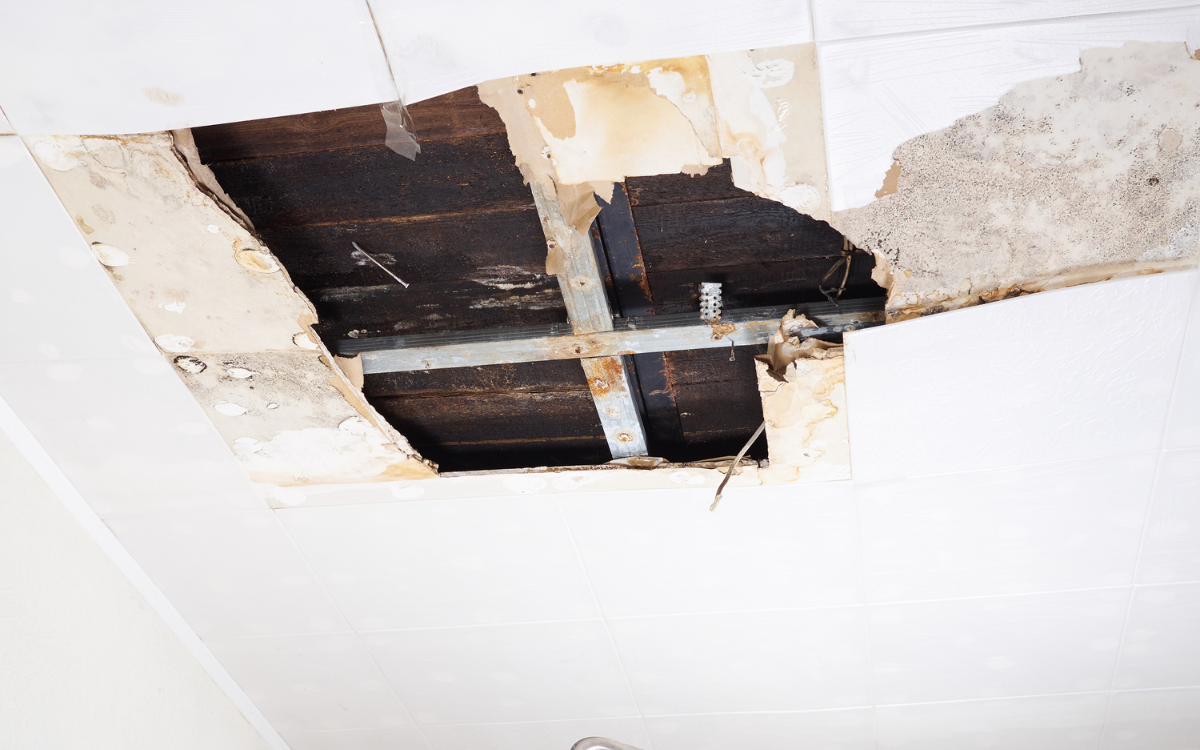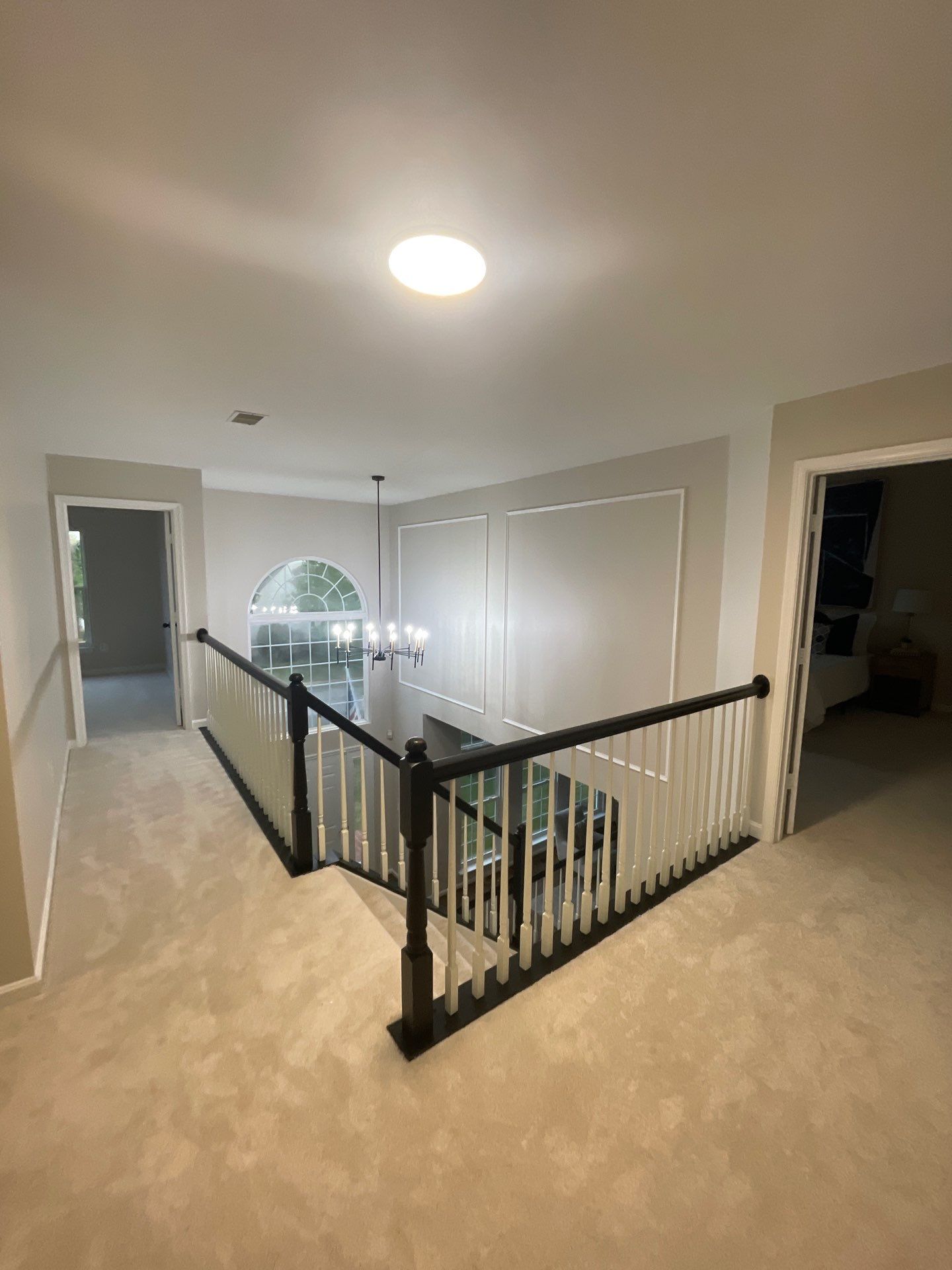Water stains on the ceiling aren’t just an eyesore—they’re a warning sign. Whether it’s from a plumbing leak, a damaged roof, or poor ventilation, ignoring it can lead to bigger headaches like mold, mildew, and drywall damage. So, what’s the best way to remove ceiling water stains and make sure they don’t return?
If you’re in Martinsburg, WV, and dealing with those annoying brown rings or straight-line water stains on your ceiling, don’t stress. This guide will walk you through the process of identifying the root cause, cleaning the stains, and properly repainting so your ceiling looks as good as new.
Key Takeaways:
- Plumbing issues, roof leaks, or humidity buildup usually cause ceiling water stains.
- Fixing the root cause is the first and most important step to prevent stains from coming back.
- Cleaning solutions like vinegar, bleach, or hydrogen peroxide help lift stains effectively.
- Proper priming and repainting ensure a flawless, long-lasting finish.

Common Causes of Ceiling Water Stains
How to remove ceiling water stains? Before you grab a paintbrush, you need to figure out what caused the stain in the first place. Otherwise, the problem will just come back. Here are the most common culprits:
Plumbing Leaks Above the Ceiling
If the stain is directly under a bathroom, kitchen, or laundry room, a slow plumbing leak is the likely issue. A small pipe leak can create moisture buildup, leading to mildew, drywall damage, and eventually a stained ceiling. Left unchecked, it can cause structural problems and even affect your home’s air quality.
Roof Damage & Drainage Issues
A stained ceiling in the middle of a room or along an exterior wall may point to roof problems. Cracked flashing, missing shingles, or clogged gutters can allow water to seep into your attic, making its way to your ceiling. If the stain appears after heavy rain, your roof may need attention.
Humidity & Poor Ventilation
High humidity in spaces like bathrooms and kitchens can lead to condensation, which eventually causes ceiling stains. Poor ventilation makes it worse, allowing moisture to settle on surfaces. Over time, this creates the perfect conditions for mold and mildew to form.
Clogged Gutters & Water Overflow
When gutters are blocked with leaves and debris, water can’t drain properly. Instead, it finds its way into your home’s structure, leading to water damage and unsightly ceiling stains. Regular gutter maintenance is a simple way to prevent these issues.
Fix the Root Cause Before Cleaning the Stain
No matter how well you clean a water stain, it will return unless you fix the problem causing it. Here’s what to check:
✔ Inspect the Roof. Look for missing shingles, cracked flashing, or clogged gutters.
✔ Check for Plumbing Leaks. Look under sinks, inside walls, and around appliances for slow leaks.
✔ Improve Ventilation. Install exhaust fans in moisture-prone areas to keep humidity under control.
✔ Clean Gutters & Ensure Proper Drainage. Prevent water buildup that can seep into ceilings.
Once you’ve addressed the source of the leak, it’s time to remove the ceiling stain.
Best Ways to Remove Ceiling Water Stains
Depending on how stubborn the stain is, different cleaning methods can help lift discoloration and prepare the surface for painting.
1. Vinegar for Light Stains
For minor stains caused by humidity or condensation, vinegar is a simple yet effective solution. It works as a natural cleaning agent that breaks down mineral deposits without harsh chemicals.
- Mix equal parts white vinegar and water in a spray bottle.
- Spray the stain and let it sit for 15 minutes.
- Wipe with a sponge and repeat as needed.
2. Bleach for Mold & Tough Stains
If mold or mildew is present, bleach is a powerful disinfectant that removes stains and prevents future growth. However, use caution and ensure proper ventilation while handling bleach.
- Mix 1 part bleach with 3 parts water.
- Spray the stain and let it sit for 10 minutes.
- Wipe with a damp sponge and rinse with clean water.
3. Hydrogen Peroxide for Deep Stains
For stubborn, set-in stains, hydrogen peroxide provides a milder alternative to bleach while still being highly effective. It also has antifungal properties to help prevent mold regrowth.
- Spray 3% hydrogen peroxide directly onto the stain.
- Let it sit for 30 minutes.
- Blot with a damp cloth and let it dry completely.
Professional Ceiling Repainting: The Key to a Perfect Finish
Even after cleaning, some stains may still show through. That’s where Appaloosa Painting Co. comes in. Here’s our interior painting process for ensuring your ceiling looks flawless and lasts for years to come:
- Thorough Prep Work: A smooth finish starts with proper prep. Our team sands rough areas, patches cracks, and ensures the surface is clean before applying paint.
- Apply a Stain-Blocking Primer: A high-quality stain-blocking primer prevents water stains from bleeding through the new paint. Oil-based and shellac primers are the best choices for sealing water damage.
- Choose the Best Ceiling Paint: Ceiling paint should resist moisture and stains while providing an even, professional finish. We use flat or matte finishes to hide imperfections and blend well with existing surfaces.
- Expert Paint Application: Our skilled interior painters in Martinsburg WV apply paint evenly to avoid streaks and uneven patches, ensuring a seamless finish that lasts.
So, how to remove ceiling water stains? Cleaning and repainting a stained ceiling can be a time-consuming task, especially if there’s drywall damage or stubborn stains. Our experienced team offers expert stain removal, drywall repair, and professional interior painting services in Martinsburg, WV.
📍We proudly serve Winchester, Sterling, VA, and the surrounding areas.
📞 Call us at 540-202-7600 for a FREE estimate today!



